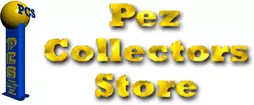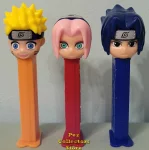Identifying Fake Regulars, fake Witch Regulars and Fake Advertising Regulars
There was a batch of Regulars, Witch Regulars and Advertising Regulars that were sold to dealer John LaSpina in 1997 or 1998. These regulars were the property of Curt Allina, who had been the executive vice president of PEZ from 1953 - 1979. John looked at these and compared them to known ad regulars and determined they were fake. John had some testing done on these which supported his belief that they were fake. John returned them, but they were never destroyed and sadly, some were sold through various sources, so they could be in collections. These fake regulars, advertising regulars and witch regulars have surfaced again in 2013. Follows is information which has been compiled to help collectors identify the fake pez, which we wrote and sent as part of the Pez Collectors Store Newsletter in June, 2013.



















In early April, I was contacted by a man from Sacramento, CA who claimed to have 364 vintage regular pez. The photos below, which show advertising pez, some plain regulars and 37 Witch regulars, were included. The man claimed to have been given these 5 years ago by his friend and former business partner, Curt Allina (the original president of Pez Candy, Inc.).
Dispensers from this same batch of pez were previously sold to John LaSpina, a well-known pez collector and dealer. John was suspicious of these as the print on the ad regulars is different than known vintage pieces. John had them chemically tested and discovered that they were printed in the 1990s. It even could be that the regulars themselves were made in the 1990s – the molds were available and the hobby was booming at that time, which invites fraud to occur! This same batch of fakes reappeared in the hands of the man from Sacramento.
A week later, I was contacted again by the seller. He had been told these were likely replicas. He did not want to incur the cost of a verification process and he stated, “It would be unfair and illegal to offer them as new when I can’t vouch for their origin(s).” I offered to have the testing done through the chemistry department at the University of Missouri where I worked and he indicated he would send some to me the following week. My emails after that were not answered and I never received samples for testing. Despite being warned that these were likely replicas, there are at least 4 individuals who purchased them at extremely cut rate prices, for a penny on the dollar and who now are in possession of these fakes.
At least some of the individuals who purchased the fake dispensers are dealers that resell pez. Sadly, the distribution is fairly broad in at least 3 states in the USA (in CA, WI and FL) and in Finland. One individual took over 100 assembled fakes, plus loose stems and caps with sleeves to a well-known and highly respected collector who has an outstanding collection of legitimate vintage regulars so that a comparison to known vintage ad regulars and witch regulars could be done. After comparing and noting certain characteristics of all of these regulars, the collector shared photos of his findings with me. I am now sharing these photos with you so that you can learn to identify the fake pez. The true, known legitimate vintage pieces are shown on the top of the photos and the fakes are on the bottom.
Note that the printing is much crisper and more ‘perfect’ on the fakes. This is not because they are more ‘mint’, but because the process used to print the dispensers in the 1990s was much better than the processes available for printing in the 1960’s. John LaSpina’s paint testing showed these were printed in the 1990s.
real on top, fake on bottom in all photos
Note there are differences in the font, print size and sometimes slant or angle of the printing, or angles such as the on the Indian Chief’s headdress which are incorrect on the fakes. These differences can be hard to distinguish if you don’t have these photos or a legitimate regular to compare to.
There are some characteristics that are common to every single regular in this lot and make it likely that they were all made from the same mold pieces.
First, the cap does not line up properly and shows a bit of white sleeve on the left, back side of the cap by the hinge (the side you see when the thumbtab is up and on the right of the cap). This gap of exposed sleeve is present on every one of the fakes. This is not generally seen at all on legitimate regulars. Additionally, notice the dimple that is present just below the peak of the thumbtab. On every one of the fakes, a dimple or dent just below the peak of the thumbtab can be seen. This molding irregularity is known to occur occasionally, on some metal pin and on some plastic hinge hole caps, while other metal pin or plastic hinge hole caps do not show the dimple. This further suggests that the same mold was used to create all of these parts.

Further, the cap of the fake regulars is skewed to the left side when viewed from the front. Notice how the cap center line does not match up to the center line of the stem, and the sides are offset.

For legitimate pez, there are 4 different styles of caps for regulars - the tall thumbtab and the short thumbtab. Further, both the tall thumbtab and short thumbtab may come with a metal pin or plastic hinge holes. Certain dispenser are known to have come with tall thumbtabs, and metal pins while others came with short thumbtabs and metal pins, while others came as tall or short with plastic hinge holes. The fakes in every single case have a tall thumbtab and metal pin. This is probably because they were all likely made from the same mold. Some ad regulars are known to come with short thumb tabs or with plastic hinge holes, (ex. Royal Toffee, Sports Chief and Seven PEZ daily should have short thumbtabs with metal pins). In every case, the fakes are made with tall thumbtabs and metal pins.
real has hinge hole for plastic head spring, fake has metal pin, though real ones can also come with a metal pin.
real has short thumbtab, fake has tall thumbtab
The fake ad regulars and fake regulars all have a no shadow (just blocks with no shading on the edges) PEZ patent number side and the fake regulars all have a shadowed PEZ side. This combination of mixed shadowing is unusual. Snow White is known to come on a shadow, no shadow stem, but it is reversed, with the shadow on the patent number side and the no shadow on the PEZ only side. Legitimate regulars come with no shadow on both sides or shadow on both sides, but the mixed shadow, no shadow is not commonly seen (I have never seen it, and haven't found anyone who has seen it on a regular). The molds used for creating these regular must have used a no shadow patent number side mold with a shadowed PEZ only side mold which is generally not done.



Perhaps the most definitive identification method for these fakes is to look for the No Shadow PEZ with patent side which will be present on all of the fake regulars and all of the fake ad regulars. Look at bricks in the curve of the P where they form an angle or V shape between the bricks. On the fakes, the bricks are cut straight down, so the V goes all the way in and pebbling is shown filling the whole V area. On all legitimate no shadow stems, the spaces between the bricks are more beveled so that the pebbling can only be seen about half way into the V and the other half is beveled to the tip of the V area as part of the lettering. There is no known legitimate dispenser that has this characteristic, but it is present on all of the fake regulars (except the witch regular which is a blank stem printed with the witch on both sides).

This lot represents a mix of 8 different colored stems and caps made with the same colors plus black caps. The fake regulars are mixes of the different colored stems and caps, some of which are in combinations that are not known to exist, making them highly suspect. These same color stems and caps are used in the Advertising regulars.
Also included with the 100 or so regulars and ad regulars were additional unassembled caps attached to sleeves and printed and unprinted stems. Below are photos of some additional ad regular stems that are believed to be fake.
There is no reason that a group of 364 regulars, representing some 21 different cap and stem color combinations, and 12 different ad regulars, should all have the exact same characteristics of metal hinge pin, tall thumbtab, dimple below the thumbtab, cap misaligned to the stem and sleeve, no shadow patent side and a shadowed PEZ only side and for every ad regular to have printing variations that are not seen in legitimate dispensers, unless these are all made from the same molds and printed as replicas.
People create fake pez dispensers because they believe that they will make lots of money by selling these to unsuspecting collectors. They attempt to replicate vintage pieces that have a high value because that is where the most money can be made. Sadly, this devalues legitimate pieces and it is a black mark on the hobby. Collectors who care about the hobby and their collection would not want to encourage the dishonest fakers by purchasing a fake dispenser, even if it were at a fraction of the price of a legitimate piece. Even if you planned to keep it, you will eventually die and the collection will be passed on to someone who won’t know that it is fake. If you value your collection, don't encourage dishonesty by purchasing a fake. Be on the lookout and don’t let the dishonest people ruin our hobby!



